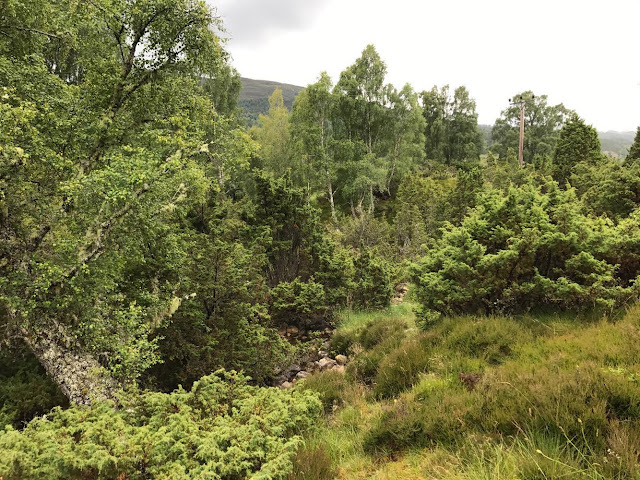Giant Time, Fast Changes: Why Concepts of Time Matter in Rewilding
Time, and especially timescales, though human inventions,
are a challenge in rewilding theory. In order to imagine a future for a
rewilded area, no matter the size or intention, we need to tweak our preset inclinations
toward timescales that represents a single human generation, or even worse, the
unnatural square number- fifty years, a century.
Our imagining of time through what we experience in a lifetime,
or that we learn from our immediate predecessors, creates a ‘shifting baseline,’
where the baseline of which we expect a natural habitat to be flourishing
degrades over time because humans will think of the safe or healthy moment to
be one from their experience; someone might be shocked to see one fish swimming
in a river when they used to see ten when they were younger, but ten
generations before there might have been hundreds of fish.
Rewilding requires us to think on a scale not in the history
of human civilization, but the history of life on the planet, the history of an
unchallenged wilderness. The presence of humans within this history is almost
laughable in its length of time, and yet the effects we’re responsible for are less humourous. The
ancient forests that spread across Europe and the Americas are almost completely
diminished. Just 2.5% of the U.K retains any ancient woodland cover, and this is still
on the chopping board for removal for developments such as High Speed Rail 2
(HS2), a new high speed rail network to connect Scotland and Northern England
with London. Humans have made huge impacts in bringing about
environmental (and climate) change since we first started using tools; by
possibly overkilling the large mammals such as the mammoth and megatherium (or Ground/
Giant Sloth) whose high environmental impact on tree and shrub spread and
development through migration, use and diet created a mosaic-like landscape of interchanging
glades and grasslands in the Pleistocene, we may have brought in the conditions
for the vastly sprawling rainforests that characterized the Holocene, as trees
no longer had an abundance of megafauna to contend with their spread.
Many now argue that the much faster and impactful changes we
have brought about in just a few hundred years have marked an end of the
Holocene and the start of an epoch characterized by human influence; the Anthropocene.
Some also call this the ‘Capitalocene,’ arguing that rather than a collective
driving force of human will, the monumental changes have been made in the name
of the economy and wealth growth. There are hypotheses for possible eras after
the Anthropocene; Dr. Glenn Albrecht argues for the pursuit of a ‘Symbiocene’
characterized by the re-integration of humans into the environment and a symbiotic
relationship between all living things, instead of the domination by humans
characterized in the Anthropocene.
When we are thinking about the health of an ancient system
of sustaining life we need to imagining time in these grand scales, not just
imagining what our grandparents might have witness and what our grandchildren
might in the future, but what the first humans must have lived with, and what
generations in the future, unrelated to and unaware of us, will be contending with
depending on our actions- even, in a post- human world, what world non-humans
will be expected to try and survive in in perpetuity (I have written about this,
my more nihilistic argument for rewilding, here.)
After adjusting the controls of our imagination to allow our
lived experience to slot in, almost insignificantly with the megaliths of epochal
timescales, it can be reassuring to witness change happening fast- from a few
years to a few decades, we have witness real positive outcomes from rewilding
projects such as the effect of reintroducing wolves to Yellowstone National Park
in 1995; the wolf population’s impact resulted in healthier rivers with
beavers, healthier and more appropriate populations of elk, and better tree
cover. In the UK, Knepp Estate, a rewilding estate in West Sussex established
in 2001, reintroduced hardy mammals (namely Tamworth pigs, Longhorn Cattle, and
Exmoor ponies) which happily fell back to a wilder life. Since then, the estate
has seen the return of endangered species such as the purple emperor butterfly,
the nightingale and the turtle dove. Rewilding agendas see results fast,
especially with the reintroduction of ‘keystone’ species= species which have a
knock-on effect other animals and plants in a system. If unchallenged, the
results can be potentially ever-expanding, ever-evolving, and everlasting.
It’s just as well that rewilding yields positive results for
biodiversity, ecological systems and climate because time is simply running out.
Governments are slow enough to set themselves and their nations targets to
meet, let alone actually make the distance and meet them. With climate rapidly
changing and becoming unpredictable and biodiversity dropping as more and more
species are lost forever, we just cannot be assured that we will be in a
survivable situation in 2030 or 2050 or any other year that sounds good (for a
long time, 2020 was the far-off challenge of a target…)
We need to allow the raw energy and power that created the
natural resources and sustaining systems that we have been polluting or
decimating to take control once more. To summarise the implications of time in
rewilding; we need to imagine time as huge, and our particular cosy moment can
be take a positive turn very fast, or a negative end just as fast. If we
incorporate wilderness back into the global landscape we can see an era beyond
the Anthropocene based on harmony with the natural world, or it can be the
final human era.
Albrecht, Dr. Glenn. “After the Anthropocene”. The Ecologist. www.theecologist.org/2019/feb/27/after-anthropocene
Farquhar, Brodie. “Wolf Reintroduction Changes Ecosystem.” Yellowstone National Park. yellowstonepark.com/wolf-reintroduction-changes-ecosystem/
Monbiot, George. Feral:
Rewilding the Land, Sea and Human Life. (London: Penguin, 2014.)
Tree, Isabella. Wilding: The Return of Nature to A
British Farm (London: Picador, 2018.)
More articles I've written about rewilding:



Comments
Post a Comment